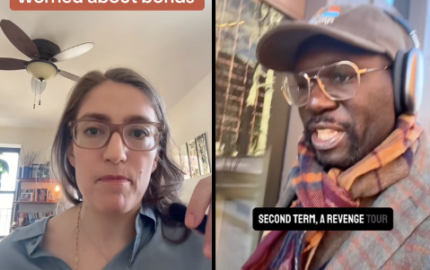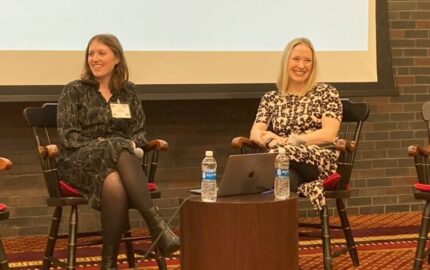How did "In Verse" come to be?
It’s really just a collaboration between poets and photographers and a radio producer—me—to report stories about the working poor. That was the initial idea. The project was conceived in November 2008, which was just about two months into our economic crisis. And there were a lot of stories at that point pulling apart questions like “What are credit default swaps?” And there were a lot of stories and worries about the super-wealthy not being wealthy anymore, and worries about the middle class slipping a notch. The group who created this project thought it was a good opportunity to look at the people getting less coverage—those further down the economic ladder, who’d already been in trouble before the collapse.
 What has your role been in the project?
What has your role been in the project?I created the project with Ted Genoways, the editor of the Virginia Quarterly Review. It came about because I was invited to apply for a grant, the Makers Quest 2.0. The grant itself, from the Association of Independents in Radio, was created to ask individual producers to come up with ideas to lead public radio into a realm of public media.
Everything is melding together—print people and television people. Radio people are often writing for print now in a way they weren’t before. All the media seemed to be getting combined online. They created the grant to give individuals an opportunity to explore, and I was one of eight producers given a grant. I had long loved VQR and had wanted to work with Ted. So when this grant came up, I called him up and said, “Let’s use this as an opportunity to do work together.” He and I had a series of conversations that led to “In Verse.”
He commissions poetry on a regular basis. This seemed like an opportunity to do something he was already doing and to do it a little more deliberately, using more than one medium. So Ted was just huge—he had been thinking about this for a long time. I was lucky enough to see that he had a special idea, and I knew how I could make it work.
Why poetry?
Poetry was in it from the beginning. Ted spoke in passing about wanting to have a corps of poet reporters. I’m not a poetry reader— but something about it made so much sense to me. I could see and hear how it could work, how nice it could be to hear news or things that we think of as news from a really difference perspective. I felt validated and wonderful when an Israeli newspaper gave and issue over to poets and fiction writers for a day. Poets wrote the weather and stock quotes, everything.
Were you thinking of other examples?
C.D. Wright's book One Big Self, about the prison system in Louisiana. There was also LiveHopeLove from Kwame Dawes. So there is a tradition, which Kwame Dawes realized so beautifully.
It’s a very contemporary combination of audio, print, and images, yet the poems make reference to classic literature via the “Women of Troy” title.
My understanding is that in “The Trojan Women” play, the men go off to fight the war, and they're killed. With the absence of the men, the women are left. And there is that odd similarity to the city of Troy, N.Y., where a large part of the male population is incarcerated. There is certainly a middle class and there are educated folks, but in this community of women, men are not part of the household and daily existence.
One reason I like this project is that poetry sticks with people. There’s a reason people still do it. It can reach into a psychological state of being in a way that a traditional journalist couldn’t get the time to do or wouldn’t do. It’s a story about generational poverty. There’s little change from generation to generation. In traditional journalism—I don’t know if it’s the expectation on the part of readers, listeners, editors or reporters—a lot of the reaction is “Why is this? How can we stop this?”
I think what a poet can do is to not ask why, but to see it, and record it, and present it. I think the poems are very true to Billie Jean and DJ. I spoke to them recently. It took a long time to get them the piece, because they had moved. About a week before Christmas, I was waiting to hear back from DJ. First she sent me a text: “I got it now. I’m crying.” And then I think she just sent, “OMG.O-M-G.”
I asked, “What does that mean?” I asked if it felt right. I was worried she wouldn’t come across tough enough. Or too tough. But she’s a really strong person. When I asked her if it felt right, she said, “Yes. I listened to it with the kids, and the only part they didn’t like was when you talked about the nits.” That was the complaint. I don’t really know why she cried—maybe she just thought of her grandma. But it touched her.
You said in a post on Transom.org that you imagined that “like Joe [Richman]’s diaries, these pieces would be narratives rooted in scenes.” Can you talk about how the pieces work as narrative nonfiction stories in each medium?
If you think about “Just a Girl,” there are scenes. There’s the parade [for Flag Day]. It’s really a holiday most of us don’t celebrate much anymore, but this was an epic parade, and she got all dolled up.
When Susan and I were out, we co-reported everything. We prepped together, we did the interview together, and we debriefed together. I don’t think that kind of true documentary work happens much anymore. You just follow people around and do what they’re doing and document their life. Which is not to say, “Hey, I want a scene in the New York Office of Temporary Assistance.” You say, “What are you going to do today?”
We spent just a tremendous amount of time with these women; Susan can tell you this. I think she was stunned by how much time we spent. For her, she would see some things and say, “I have enough,” but as a radio person, where not much is going on, I love it. I need to record that, too.
I think in that “Just a Girl” piece, you feel that you’re at the parade with her, because we were at the parade with her. The poem with DJ and her mom, we spent a lot of time at DJ’s home and her mom’s home, we spent a lot of time just being there—you can hear that. You hear her making dinner, making pork chops.
What has the response been so far?
People are liking it, loving it. Which is really, really gratifying. I think people want to see more. I want to do more. I’m speaking to two radio stations who are interested in doing installments in their communities. In that case, I’d work with Ted to find a poet—Ted’s been the one to cherry-pick and recommend the poets. That’s one of his jobs on this project.
This grant was a beautiful grant, but it was a modest grant. I was given $40,000 and required to use it over a five-month time period. Gulfport [the second installment of “In Verse”] and Troy both happened within a five-month period.
What did you change in doing the second installment?
Both kind of happened at the same time; there was great overlap. Troy started a little bit earlier, but they very much happened at the same time. With such a particular deadline, it is difficult to build a real relationship to get intimate tape and find subjects in a small window. When Ted and I were planning, we looked for collaborators to work with who already had made inroads into the communities.
I truly believe that Brenda [Kenneally] may be the best photographer in the world. She has an amazing talent. She can take a picture of a young man looking at a bag of Doritos. Something that is so simple, but it’s riveting. She can capture that kind of longing and secret wish. She really has the tenacity and the talent—a lot of her strongest work is framed simply. Like on the Huffington Post, they did an article, and there was one photograph Brenda gave to them. A baby in a car carrier set in front of the TV on the floor, and on the screen is SpongeBob. There’s not a lot happening, but it says a lot. She’s saying a lot with her choices. And it makes for great commentary on American life.
She had been shooting this group of women for the last six years. Ted had seen her work and wondered, “How do I peel off part of her giant project for use in a magazine?” We couldn’t have done it without her. We would not have had the immediate acceptance from all these women without it.
Natasha [Trethewey] is from Gulfport, Miss. She wanted to go to Gulfport. She had written about Katrina. We went to Troy because on that one the photographer was our lead, and we modeled things to her work. In the other, the poet was kind of in the lead, and things came into place from there.
What’s next? Will you try anything different?
I don’t know. We could certainly do it again the way we have. Each of the poets said, “If you ever do it again, give the poets more time!” It took a lot of time as it was. I collected the tape in Troy, and then had to sit and wait until the poetry was done.
My instinct would be to see if it’s possible to do something more immediate, where the poetry could happen more in the moment. My thought is that we could do it opportunistically. Let’s get a poet and just go and actually report, the way you do an interview. You couldn’t do a suite of poems that way. But if there were an event, a breaking news story, it could be nice to cover it the way a reporter would. I’d be interested in seeing how that might work.
[Check out our commentary on "Women of Troy" and see more examples of poetry in journalism. Or read our interview with Virginia Quarterly Review's Ted Genoways on recapturing a documentary role for poetry.]


